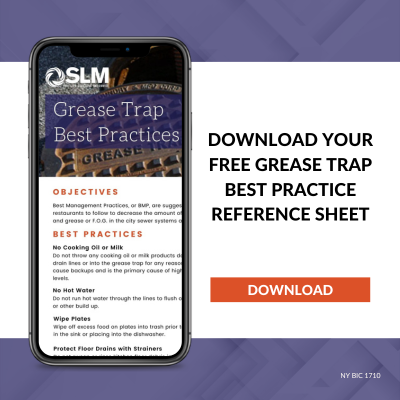Fats, oils, and grease or FOG. The triple threat causes major problems for commercial kitchens, grocery stores, and other food establishments. When these substances enter the sewer system, they cause clogs, drain backups, and pollution. Ultimately resulting in potential fines and shutdown, lost revenue, emergency service fees, and much more. That’s why having a proper working interceptor and utilizing Grease Trap Best Practices for kitchens lowers the risk of disaster.
In this blog, we’ll cover what Best Practices are, why they are essential, and additional tips when it comes to your grease trap maintenance.
What’s the Point of Best Practices?
A quick Google search of “What is a Best Practice” will inundate you with hundreds of web pages telling you the best practices for grease traps, waste management, and more. The simplest way to put it is a commercial or professional procedure accepted or prescribed as being correct or most effective. By following these procedures you’ll
- They help extend the life of your assets
- Reduce emergency costs
- Minimize downtime
- Assist in keeping you in compliance
- Protect your bottom line
- Empower your staff to prevent disasters and what to do if they occur anyway
So taking 5 mins to learn the best practices for your assets and review them from time to time will save you time, money, and potentially a headache.
But What are Grease Trap Best Practices For Kitchens?
The last thing you need to deal service grinding to a halt on a busy Friday night because the grease trap overflowed in your parking lot. Yikes! The following grease trap best practices for kitchens will help keep your traps or interceptors properly maintained. This includes:
- Regularly Grease Trap Cleanings. It’s recommended to have it pumped and serviced a minimum of once every quarter or 3 months! However, the frequency with which you need to clean your grease trap depends on the size of your kitchen, the amount of grease and oil you generate, and local mandates. Keeping up with your local municipality or state mandates is essential.
- Drain Covers, Strainers, or Sock. A strainer, cover, or sock assists with catching food particles and other solids before they enter pipes and end up in your grease trap. They prevent your grease trap from becoming clogged.
- Rinsing Dishes with Not Scolding Water. If your water is too hot it can melt grease and oil, making it more likely to enter your trap. Instead, scrap your dishes into the trash then rinse with hot, but non-scolding water to help prevent grease and oil from accumulating.
- Wipe off your plates. It’s important to discard excess food and drippings into a waste bin and not down the drain. Food particles will build up over time and cake your pipes leading to future backups.
- Do not sweep or rinse kitchen floor debris down the drain! Just like food scraps shouldn’t go down the drain, neither should dirt, grime, and other items from your floor belong in your pipes.
Additional Tips
In addition to the best practices listed above, here are a few other things you can do to help keep your grease trap in good working order.
- Smell Something Off? Contact your partner for grease trap cleanings to diagnose the odor and eliminate it. Avoid putting cleaners and other items down your drain.
- Inspect. If possible, inspect your drain covers and grease trap. If you notice damage contact the appropriate parties for repairs before it becomes worse.
- Use a Professional. Partner with a reputable company, such as SLM Facility Solutions, when it comes to cleaning your grease trap. This will ensure it’s done correctly and safely while having the sludge disposed of properly.
By following these tips, you can help to extend the life of your grease trap and keep it in good working order.
Now Put it into Practice
Grease traps play an important part in any kitchen, large or small. By following the best practices outlined in this post, you help ensure your grease trap is properly maintained and reduce the risk of clogs, backups, shutdowns, and more!
Looking for a partner to help you maintain your grease trap services? SLM Facility Solutions Nationwide has over 25 years of experience helping restaurants, coffee shops, grocery stores, convenience stores, and more manage their grease trap services. Along with completing repairs, installations, and replacements. Ready to get started? Contact us today!
BONUS Help Train Your Staff with Our Free Download
Training your staff is crucial to ensuring Best Practices are followed. Grab your copy of our Grease Trap Best Practice for Kitchens below.




